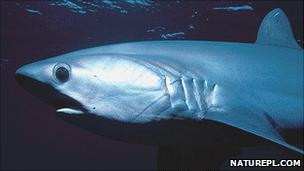Sharks navigate using 'mental maps'
- Published

Tiger sharks can navigate on scales of many kilometres - perhaps aided by internal maps
Some shark species make "mental maps" of their home ranges, allowing them to pin-point destinations up to 50km (30 miles) away, research suggests.
US-based scientists analysed data from tiger sharks tagged with acoustic transmitters, and found that they took directed paths from place to place.
Other species such as blacktip reef sharks did not show this behaviour.
Writing in the Journal of Animal Ecology, external, researchers suggest this shows a capacity to store maps of key sites.
In addition, it is further evidence that the great fish can navigate, possibly using the Earth's magnetic field.
Earlier research in Hawaii had shown tiger sharks swimming across deep channels and finding shallow banks rich in food 50km away.
In this project, researchers used statistical techniques to show the journeys were not made by accident; the sharks were following some kind of path.
Blacktips, however, did not. A third species, thresher sharks, also showed "directed walking" like the tigers, but on much smaller scales.
"Our research shows that, at times, tiger sharks and thresher sharks don't swim randomly but swim to specific locations," said research leader Yannis Papastamatiou from the Florida Museum of Natural History in Gainesville.
"Simply put, they know where they are going."
Maps and magnets
A key question is how they know where they are going.
Sharks are among the wide array of animals that can sense magnetic fields.

Thresher sharks proved less able navigators
But whereas others, such as yellowfin tuna, apparently do this using small amounts of the mineral magnetite in their heads, sharks do not appear to maintain deposits of this magnetic sensor.
Alternative possibilities are that they use signals from ocean currents, water temperature or smell.
"They have to have a pretty good navigation system because the distances are great," Dr Papastamatiou told BBC News.
"Which one it is is open to debate, but the fact that many of these journeys took place at night - you and I would think there's nothing to orientate to, so orientating to magnetic fields is one possibility."
Among thresher sharks, adults made much longer directed journeys than juveniles.
The researchers say this suggests the fish build up mental maps as they mature.
The differences between species are probably explained by the varying ways in which they live.
Blacktip reef sharks (Carcharhinus melanopterus), although widespread around the Pacific, appear to have small ranges within their home reef system.
On the other hand, tiger sharks (Galeocerdo cuvier) can cover huge distances. Tags have been recovered from individuals more than 3,000km away from where they were attached.
- Published27 January 2011
- Published9 December 2010